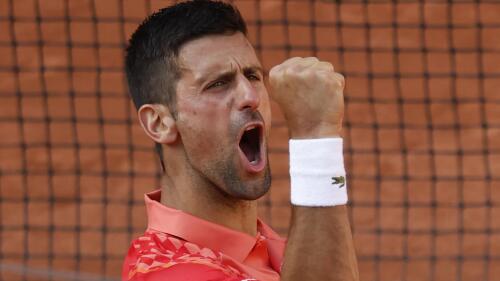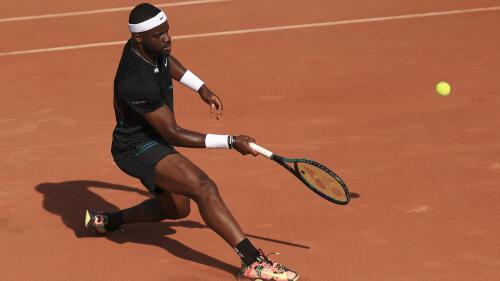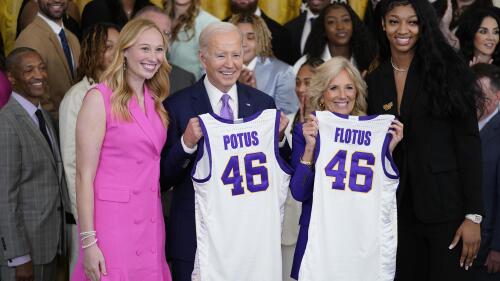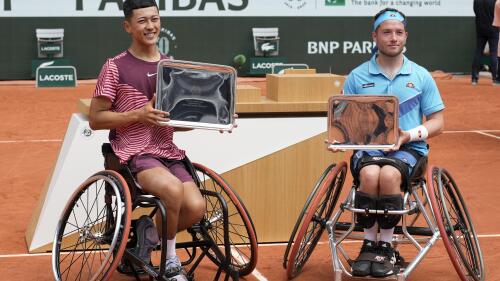Esther Vergeer had few role models in wheelchair tennis and limited opportunities when she took up the sport.
Those aren’t problems any more, and she’s a big reason why.
“That was also what I liked about my career, is that I know I was the one that pioneered. I was the one that could explore it all. And I was the one that needed to figure out what the pathway was,” Vergeer said in a telephone interview as she prepared for her induction into the International Tennis Hall of Fame. “That was also the fun part.”

Carlos Alcaraz and Novak Djokovic will face each other in the French Open semifinals. It is their first head-to-head meeting in more than a year.

The group that runs the French Open tennis tournament has hired an artificial intelligence company to monitor players’ social media accounts in a bid to try to protect athletes from cyberbullying.

President Joe Biden has appealed for more support for female athletes during a White House event celebrating Louisiana State’s championship women’s basketball team.
Vergeer will be added to the Newport, Rhode Island, shrine on Saturday along with American Rick Draney, who won 12 singles titles and six in doubles before the Grand Slam era of wheelchair tennis. Draney has been credited with bringing quad tennis – a classification that accounts for impairment in the arms as well – to the Paralympics and other top tournaments.
A 21-time Grand Slam singles champion and seven-time Paralympic gold medalist, Vergeer began her career in an era when wheelchair tennis wasn’t included in the top events and retired as its most dominant player, holding the No. 1 spot in the world rankings for 668 weeks from 2000-13 and winning 470 straight singles matches. She won 96% of her singles matches in all, and also won 136 doubles titles.
“She’s a legend of the sport,” current No. 1 Diede De Groot said this month before winning Wimbledon for her 11th consecutive Grand Slam wheelchair singles title and her 111th match in a row — a streak second only to Vergeer’s. “Being in the position that I am now — having a very long streak but still not being nearly to her streak — my respect only grows for her. That she was able to 10 years in a row where she was just absolutely dominant, it’s a little bit crazy for me to think about that. She deserves all that’s coming to her.”
Vergeer suffered from a series of strokes as a child, and an operation to address an abnormality in her spinal cord blood supply left her legs paralyzed. She also played volleyball and won a European wheelchair basketball championship before devoting herself to tennis.
At the time, the sport was still establishing itself. Although wheelchair singles became an official sport at the 1992 Paralympics, it wasn’t added to the Grand Slam tournaments for more than a decade after that.
“When she was on top of the game, (wheelchair) tennis was still growing so much,” de Groot said. “So she was really at the start of it, when it was growing. So she’s been so important in helping that and helping it start up. She was really part of the foundation for that big growth.”
A sports-loving country that cleans up in speed skating, cycling and swimming, the Netherlands has had little success in tennis: Richard Krajicek (Wimbledon, 1996) and Kea Bouman (French Open, 1927) are the only Dutch players to win major singles titles.
It’s a different story in wheelchair tennis — and especially on the women’s side. The Dutch women have won 18 of a possible 24 singles medals at the Paralympics and all seven Wimbledon singles titles since wheelchair was added to the program in 2016; at the U.S. Open, where wheelchair has been included since 2005, Holland has topped the podium 12 of 15 times in both singles and doubles.
Although de Groot joked that the Dutch success comes from the drinking water, Vergeer praised her homeland for providing equal resources such as training facilities and experts for para and other athletes. That helped make it a pioneer, and the results are still visible.
“Since I was very little, I’ve followed her every step of the way,” de Groot said. “So many people, including me, saw her do all of the things we only dreamed of. She’s been a big influence.”
Vergeer called that “the biggest honor you can ever have.”
“If I can be a role model for next generation players, that is a big compliment. I wish I had that when I started playing tennis,” she said, adding that newcomers today might be looking up to players like de Groot in the same way. “And at the same time I realize that I am over 40 and maybe I’m not the role model anymore. … So it’s for the next generation to come to, to make (the) next heroes.”
___
AP Tennis Writer Howard Fendrich contributed to this story from Wimbledon, England.
#Wheelchair #pioneers #Ester #Vergeer #Rick #Draney #inducted #Tennis #Hall #Fame












Leave a Reply